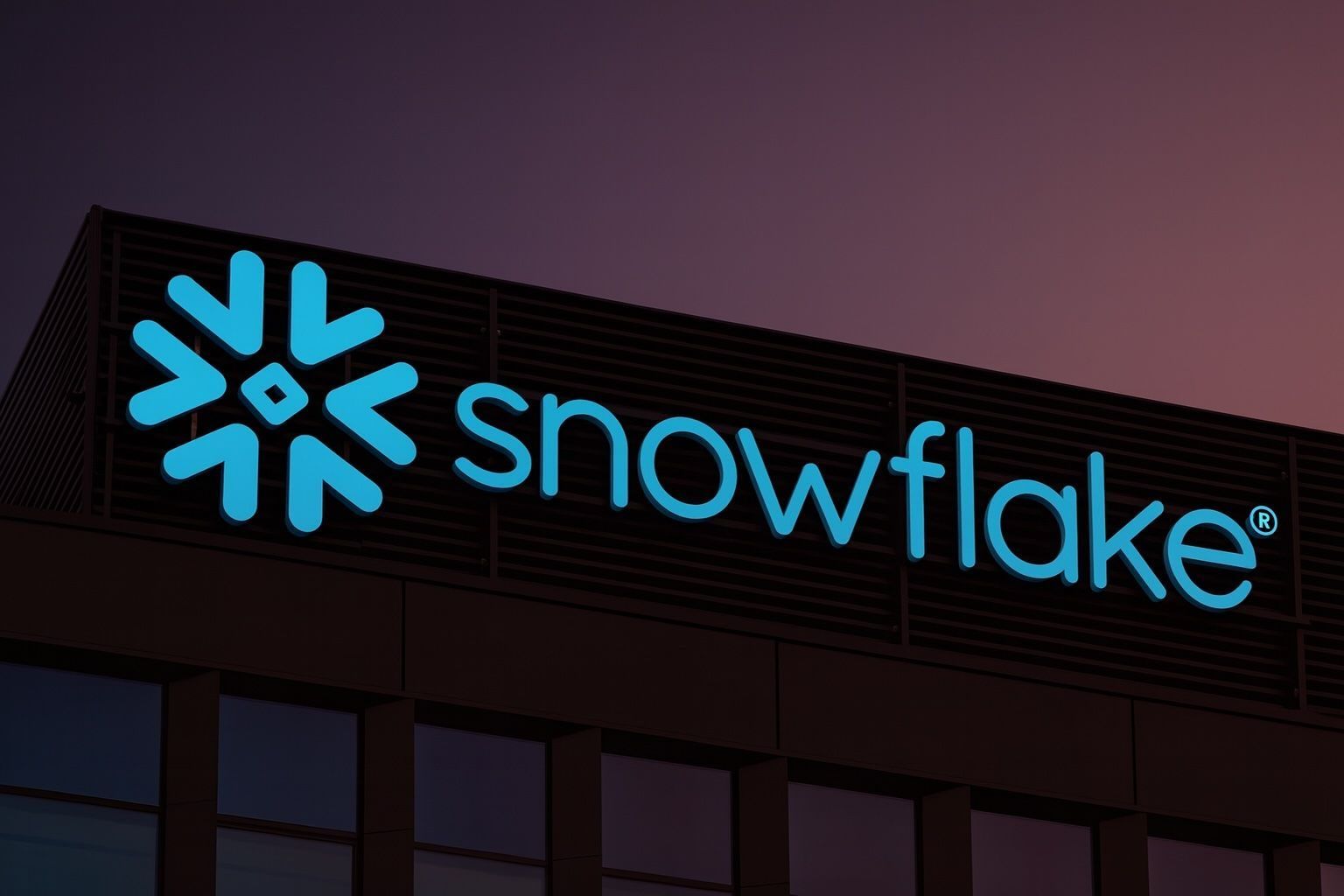Snowflake (NYSE: SNOW) heads into Monday’s open after a huge 2025 rally, fresh AI product launches, a Datometry acquisition, analyst upgrades, and an earnings catalyst on December 3. Here’s what traders and investors should watch on November 17, 2025.
Key takeaways before Monday’s open
- Snowflake shares have surged more than 60% year‑to‑date and roughly doubled over the past 12 months, closing around $257 on Friday, November 14. [1]
- The company recently reported Q2 FY26 product revenue of $1.09 billion, up 32% year over year, with a 125% net revenue retention rate and $6.9 billion in remaining performance obligations (RPO), underscoring sticky, expanding customer spend. [2]
- Q3 FY26 earnings are due after the close on December 3, 2025, with Wall Street expecting EPS of about $0.31 and revenue of roughly $1.18 billion, implying mid‑20s percentage growth. [3]
- Snowflake is in the middle of a major AI and data‑cloud product cycle: a deep SAP partnership, new agentic‑AI tools, and an “enterprise lakehouse” expansion all dropped in early November. [4]
- The company just agreed to acquire Datometry’s migration technology, aiming to make moves from legacy data warehouses (like Teradata and Oracle) to Snowflake up to 4x faster and up to 90% cheaper. [5]
- Analyst sentiment is broadly bullish: RBC recently raised its price target to $300, BTIG to $312, and several banks lifted targets after Q2 results—while valuation metrics like forward P/E above 200x and a P/S above 20x flag a richly priced stock. [6]
- Institutional and insider activity is mixed, with some funds adding exposure and others trimming, and founder Benoit Dageville selling shares after the rally. [7]
Below is a deeper look at what all of this means going into the U.S. market open on Monday, November 17, 2025.
1. Where Snowflake stock stands heading into November 17
Snowflake closed Friday around $257.02, barely changed on the day but sitting close to its recent highs and up sharply for the year. Data from MarketScreener and StockTitan show the stock up roughly mid‑60% year‑to‑date and more than 100% over the past 12 months, highlighting how aggressively investors have repriced the name in 2025. [8]
Technical commentary from Investor’s Business Daily recently noted that Snowflake is trading in an ascending base with a buy point around $255.39, and that the stock carries a high composite rating within its software peer group. [9] With Friday’s close just above that reference level, Monday’s open will show whether buyers are willing to keep defending the breakout zone or if profit‑taking pressure builds after the big run.
From a liquidity and ownership standpoint, StockTitan data suggests Snowflake has a market cap around $87 billion, institutional ownership north of 70%, and short interest under 4%, meaning the shareholder base is dominated by long‑only and hedge fund money rather than retail traders. [10]
Why this matters Monday:
With the stock already pricing in a lot of optimism, even small shifts in sentiment, rates, or AI‑software peers could create outsized moves at the open—especially with key catalysts still ahead.
2. Fundamental backdrop: strong Q2 FY26 and sticky customers
Snowflake’s latest reported quarter—Q2 FY26, ended July 31, 2025—was a clear beat on growth and profitability, and it set the tone for the rally that followed. Highlights include: [11]
- Revenue: Around $1.1 billion, +32% year over year.
- Product revenue:$1.09 billion, also +32% YoY, and ahead of prior guidance.
- Net revenue retention:125%, indicating existing customers are increasing spend by roughly 25% on average.
- RPO (remaining performance obligations):$6.9 billion, +33% YoY, supporting future revenue visibility.
- Large customers:654 customers generating more than $1 million in trailing 12‑month product revenue, and 751 Forbes Global 2000 customers using Snowflake, both continuing to grow.
Analysts and commentators noted that non‑GAAP operating margin improved to low double digits while free cash flow margins remained healthy, demonstrating that Snowflake can both grow quickly and move toward better profitability. [12]
What to keep in mind Monday:
Investors stepping into or out of the stock ahead of Q3 earnings will be measuring any new data or commentary against this very strong Q2 baseline. A lot of the current valuation hinges on Snowflake maintaining 30%‑ish product revenue growth while continuing to expand margins.
3. Next big catalyst: Q3 FY26 earnings on December 3
The next scheduled company‑specific catalyst is Q3 FY26 earnings, set for Wednesday, December 3, 2025, after the U.S. market close. [13] Analysts expect: [14]
- EPS: About $0.31, up roughly 55% year over year.
- Revenue: Around $1.18 billion, implying ~25% revenue growth.
- Full year FY26: Consensus calls for $1.17 in EPS and roughly $4.6 billion in revenue, translating to around 41% EPS growth and 35% revenue growth versus last year.
After Q2, Snowflake raised its full‑year product revenue outlook to about $4.4 billion, implying around 27% product revenue growth, and guided Q3 product revenue to a range slightly above earlier expectations. [15] The company later reiterated that this guidance remained intact following an October SEC filing clarifying comments made in an interview. [16]
Why it matters now:
Even though earnings are more than two weeks away, Monday’s trading will already reflect positioning into that event. Traders will be watching for any pre‑earnings research notes, estimate changes, or options activity that signal how confident the Street is in Snowflake’s ability to hit (or beat) those Q3 numbers.
4. AI product blitz and the SAP partnership
A big part of Snowflake’s 2025 story is its push to be the “AI Data Cloud” of choice for large enterprises.
SAP + Snowflake: a deep AI data partnership
On November 4, 2025, SAP and Snowflake announced a deep technical partnership that enables bi‑directional, zero‑copy data sharing between SAP’s Business Data Cloud and Snowflake’s AI Data Cloud. [17]
Analyst coverage from Futurum describes this as a “market‑defining move” that helps solve one of the biggest headaches in enterprise AI: getting trusted, context‑rich transactional data into AI models without brittle ETL pipelines or constant data copying. [18]
In practical terms, the partnership aims to:
- Let enterprises query SAP data live from Snowflake (and vice versa) with zero‑copy access.
- Reduce latency and duplication costs in analytics and AI workloads.
- Strengthen the concept of a data fabric where data is accessed in place rather than constantly moved.
Snowflake Intelligence, Cortex AI & the enterprise lakehouse
Around the same time, Snowflake rolled out a series of announcements:
- Snowflake Intelligence – agentic AI capabilities for natural‑language insights over governed enterprise data.
- New developer tools to “supercharge enterprise‑grade agentic AI development,” including better tooling for building AI agents on Snowflake. [19]
- Enterprise lakehouse enhancements – StockTitan summarizes new features like Horizon Catalog upgrades, Openflow general availability, upcoming interactive tables and warehouses, a public preview of Snowflake Postgres, and enhanced support for Apache Iceberg. [20]
Simply Wall St notes that recent product launches and partnerships—including SAP and Deloitte Tax, as well as case studies like dmTECH and USA Bobsled/Skeleton—have expanded Snowflake’s role in AI‑driven analytics and data integration, reinforcing the bull case for long‑term growth. [21]
Why it matters Monday:
News flow around AI and partnerships has been a major driver of Snowflake’s re‑rating. Any additional commentary from partners, customers, or analysts over the weekend could influence sentiment at the open—especially if it suggests faster adoption or new competitive threats.
5. Datometry acquisition: making it easier to leave legacy warehouses
In the past week, Snowflake also entered into a definitive agreement to acquire Datometry’s technology and team, a startup focused on virtualizing legacy data warehouses and easing migrations. [22]
Key points from Snowflake’s blog and industry coverage: [23]
- Datometry’s Hyper‑Q virtualization platform lets applications written for older systems (like Teradata) run on modern cloud platforms without rewriting the original SQL.
- Snowflake plans to integrate this tech into SnowConvert AI, its existing migration toolset, to automate and accelerate code conversion, verification, and validation.
- Industry articles report claims of up to 4x faster migrations and as much as 90% lower costs versus traditional approaches.
- Dell Technologies Capital (a Datometry backer) and Datometry itself frame the deal as a way to remove a major barrier to adopting Snowflake—the pain and risk of large‑scale warehouse migrations.
Social‑data trackers like QuiverQuant highlight that this acquisition has started to trend among investors, with some excited about the growth implications and others cautious about integration risks and competitive responses. [24]
Why it matters Monday:
For many large enterprises, migration friction is the last big hurdle before committing to Snowflake at scale. The Datometry deal strengthens the narrative that Snowflake can convert more of the massive Teradata/Oracle installed base—a theme investors may continue to price in as markets reopen.
6. Analyst sentiment: bullish targets vs sky‑high valuation
Wall Street ratings and price targets
Recent research flow has been supportive:
- RBC Capital raised its price target on Snowflake from $275 to $300 and reiterated an Outperform rating on November 12. [25]
- BTIG maintained a Buy rating and lifted its target to about $312. [26]
- Other banks, including UBS (up to $310), BofA, Oppenheimer, Truist, and Deutsche Bank, have raised targets since the Q2 print, generally citing accelerating product revenue growth and strong AI positioning. [27]
MarketBeat’s compilation of ratings shows the stock skewed heavily toward Buy/Strong Buy, with only a small handful of Hold or Sell recommendations and an average target in the high‑$260s to low‑$270s depending on the data provider. [28]
Valuation red flags
At the same time, both Zacks and Simply Wall St emphasize how aggressively Snowflake is valued: [29]
- Zacks estimates a forward P/E over 220x and a PEG ratio above 7, versus industry averages closer to 30x P/E and ~2x PEG.
- Simply Wall St’s DCF work suggests Snowflake may be around 40–45% overvalued relative to its intrinsic value estimate (~$178 per share vs the current ~$250–260 trading range).
- On a price‑to‑sales basis, Snowflake trades at roughly 21x sales, compared with an IT sector average near 2–3x and peer averages around 19x, underscoring the premium.
Simply Wall St also notes that Snowflake has delivered a 63% year‑to‑date gain and 104% 12‑month return, but scores 0 out of 6 on its undervaluation checks, reflecting concerns that expectations might be running ahead of fundamentals. [30]
Why it matters Monday:
The combination of bullish targets and stretched valuation is exactly what can lead to sharp moves around any incremental news. Into Monday’s open, traders will be asking: is there enough incremental good news left to justify more upside before earnings, or has the stock already priced in the AI and migration story?
7. Ownership and insider activity: signals beneath the surface
Recent filings show a mixed but active ownership picture:
- Creative Planning disclosed the purchase of 31,543 Snowflake shares, adding to institutional demand for the stock. [31]
- The Ontario Teachers’ Pension Plan Board, by contrast, cut its Snowflake stake by about 53% in Q2, down to roughly 533,578 shares, though the position still represents around 2.4% of its portfolio and remains one of its larger holdings. [32]
- MarketBeat notes that company insiders collectively sold over 900,000 shares worth more than $200 million over recent periods, as executives and early holders lock in gains. [33]
On November 13, founder and Chief Architect Benoit Dageville sold 25,000 shares at an average price of about $264.45, for proceeds of roughly $6.6 million, after exercising options on the same amount of stock. [34]
How to read this for Monday:
- Institutional buying (like Creative Planning’s) supports the idea that large investors still see upside in the AI and data‑cloud thesis.
- Big insider sales are common after big rallies, but they also reinforce valuation concerns and can weigh on sentiment if they continue.
- Expect traders to watch Monday’s order flow for clues about whether fund flows are still net positive or starting to turn.
8. Is Snowflake’s rally sustainable? Bull vs. bear lenses
Putting it all together, here’s how the setup looks heading into November 17:
Bullish talking points
- Growth + stickiness: 32% product revenue growth, 125% net revenue retention, and a growing roster of $1M+ customers show a business still in strong expansion mode. [35]
- AI positioning: Partnerships with SAP, Palantir, Cognite, UiPath and others embed Snowflake deeper into the AI and automation stack of large enterprises. [36]
- Migration tailwind: The Datometry acquisition and SnowConvert AI tools aim to tear down the barrier to leaving legacy warehouses—potentially unlocking a new wave of large migrations. [37]
- Wall Street support: Upward‑revised price targets (some above $300) and Buy‑leaning consensus suggest the Street still believes in the long‑term story. [38]
Bearish talking points
- Valuation risk: Multiple frameworks (DCF, P/S, P/E, PEG) point to a stock trading at a substantial premium even relative to other high‑growth software names. [39]
- Execution bar is high: With the stock already up ~100% in 12 months, any slowdown in growth, hiccup in AI monetization, or weaker‑than‑hoped Q3 guidance could trigger a sharp pullback. [40]
- Competition remains fierce: Rivals like Databricks and other AI‑data platforms are aggressively investing, and some analysts highlight competitive pressure as a key ongoing risk. [41]
- Insider selling and profit‑taking: Continued selling by insiders and some long‑term holders may signal that some players see better risk/reward elsewhere after the big run. [42]
9. What to watch at the open on November 17, 2025
Here’s a quick checklist for Monday’s pre‑market and early‑session action:
- Price behavior around ~$255–260
- This range lines up with the recent breakout “buy point” flagged by technical analysts. Holding above it would keep the momentum narrative intact; a decisive move below may signal a deeper consolidation after the rally. [43]
- Any new notes on Datometry or SAP
- Watch for fresh research comments or customer case studies that either validate or question the impact of the Datometry acquisition and the SAP partnership on near‑term demand. [44]
- Estimate revisions ahead of Q3 earnings
- If EPS or revenue estimates start creeping higher (or lower) in the next couple of sessions, Monday’s tape may be the first place you see that sentiment reflected. [45]
- Flow from big holders and options markets
- Given the recent institutional rebalancing and insider sales, watch whether volume is dominated by profit‑taking or whether dips are being bought by new institutional money. [46]
- AI sector tone
- Snowflake often trades in sympathy with other AI‑software and infrastructure names. Any big moves in bellwethers or macro AI headlines overnight could set the tone for SNOW at the open. [47]
Final word
Heading into the November 17, 2025 open, Snowflake is not a quiet, overlooked stock—it’s a high‑expectation AI leader priced for continued strong growth. Bulls will focus on powerful fundamentals, rapid AI product innovation, and deepening partnerships; bears will point to a premium valuation, fierce competition, and signs of insider profit‑taking.
Whichever camp you lean toward, it’s crucial to align any decision with your own risk tolerance, time horizon, and portfolio needs. This article is for information and education only and does not constitute financial advice.
References
1. www.stocktitan.net, 2. www.businesswire.com, 3. www.businesswire.com, 4. futurumgroup.com, 5. www.snowflake.com, 6. www.marketscreener.com, 7. www.marketbeat.com, 8. www.stocktitan.net, 9. www.investors.com, 10. www.stocktitan.net, 11. www.businesswire.com, 12. www.nasdaq.com, 13. www.businesswire.com, 14. www.nasdaq.com, 15. www.barrons.com, 16. www.investing.com, 17. futurumgroup.com, 18. futurumgroup.com, 19. www.snowflake.com, 20. www.stocktitan.net, 21. simplywall.st, 22. www.snowflake.com, 23. www.snowflake.com, 24. www.quiverquant.com, 25. www.marketscreener.com, 26. www.futunn.com, 27. www.marketscreener.com, 28. www.marketbeat.com, 29. www.nasdaq.com, 30. simplywall.st, 31. www.marketbeat.com, 32. www.marketbeat.com, 33. www.marketbeat.com, 34. www.investing.com, 35. www.businesswire.com, 36. www.stocktitan.net, 37. www.snowflake.com, 38. www.marketscreener.com, 39. www.nasdaq.com, 40. simplywall.st, 41. www.barrons.com, 42. www.marketbeat.com, 43. www.investors.com, 44. futurumgroup.com, 45. www.nasdaq.com, 46. www.marketbeat.com, 47. www.stocktitan.net







